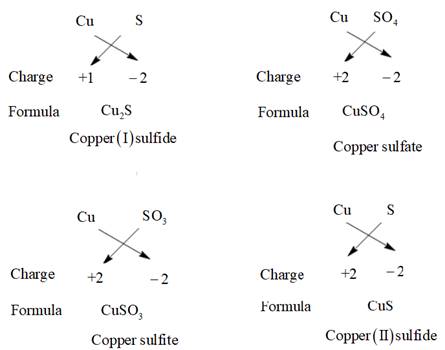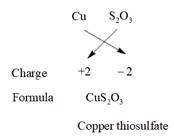
Concept explainers
Interpretation:
The number of possible compounds which can be made from copper, sulfur, and oxygen should be predicted. The charge and formula of some ions is represented as follows:

Concept introduction:
The species containing either positive or negative charge are termed as ions. Positively charged ions are termed as cations whereas negatively charged ions are termed as anions.
Answer to Problem 11STP
Five compounds are possible whose formula and name are given as follows:
| S. No. | FORMULA | NAME OF THE COMPOUND |
| 1. | Copper(I) sulfide | |
| 2. | Copper sulfide | |
| 3. | Copper sulfite | |
| 4. | Copper sulfate | |
| 5. | Copper thiosulfate |
Explanation of Solution
The charge on copper can be +1 and +2. Thus, the possible compounds which can be made are represented as follows:


Thus, five compounds are possible using copper, sulfur, and oxygen atom.
Chapter 10 Solutions
Chemistry: Matter and Change
Additional Science Textbook Solutions
Organic Chemistry
Organic Chemistry (9th Edition)
General, Organic, and Biological Chemistry (3rd Edition)
General Chemistry: Principles and Modern Applications (11th Edition)
Introductory Chemistry (5th Edition) (Standalone Book)
Chemistry: A Molecular Approach
 ChemistryChemistryISBN:9781305957404Author:Steven S. Zumdahl, Susan A. Zumdahl, Donald J. DeCostePublisher:Cengage Learning
ChemistryChemistryISBN:9781305957404Author:Steven S. Zumdahl, Susan A. Zumdahl, Donald J. DeCostePublisher:Cengage Learning ChemistryChemistryISBN:9781259911156Author:Raymond Chang Dr., Jason Overby ProfessorPublisher:McGraw-Hill Education
ChemistryChemistryISBN:9781259911156Author:Raymond Chang Dr., Jason Overby ProfessorPublisher:McGraw-Hill Education Principles of Instrumental AnalysisChemistryISBN:9781305577213Author:Douglas A. Skoog, F. James Holler, Stanley R. CrouchPublisher:Cengage Learning
Principles of Instrumental AnalysisChemistryISBN:9781305577213Author:Douglas A. Skoog, F. James Holler, Stanley R. CrouchPublisher:Cengage Learning Organic ChemistryChemistryISBN:9780078021558Author:Janice Gorzynski Smith Dr.Publisher:McGraw-Hill Education
Organic ChemistryChemistryISBN:9780078021558Author:Janice Gorzynski Smith Dr.Publisher:McGraw-Hill Education Chemistry: Principles and ReactionsChemistryISBN:9781305079373Author:William L. Masterton, Cecile N. HurleyPublisher:Cengage Learning
Chemistry: Principles and ReactionsChemistryISBN:9781305079373Author:William L. Masterton, Cecile N. HurleyPublisher:Cengage Learning Elementary Principles of Chemical Processes, Bind...ChemistryISBN:9781118431221Author:Richard M. Felder, Ronald W. Rousseau, Lisa G. BullardPublisher:WILEY
Elementary Principles of Chemical Processes, Bind...ChemistryISBN:9781118431221Author:Richard M. Felder, Ronald W. Rousseau, Lisa G. BullardPublisher:WILEY





